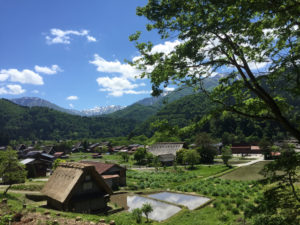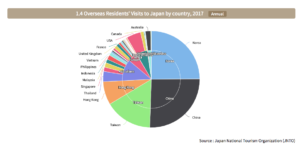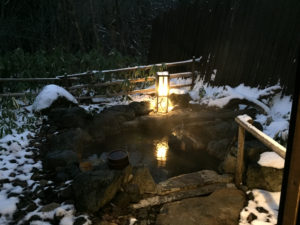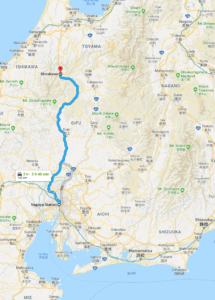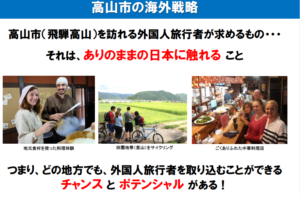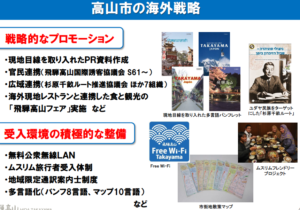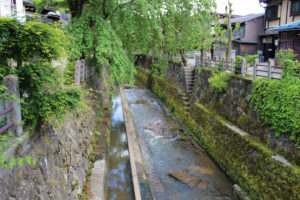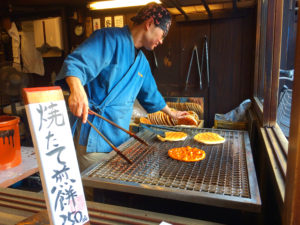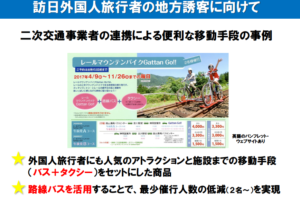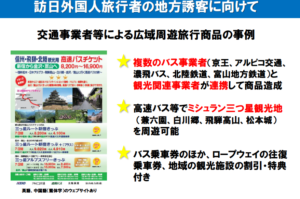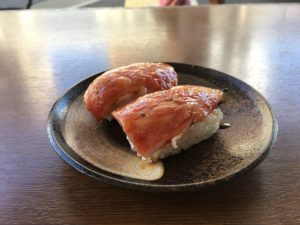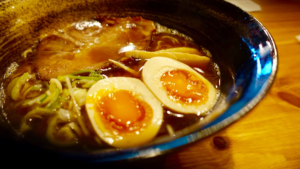(Historic village in Hida-Takayama)
It is not secret that Japan is a surprising combination of peace and chaos, old and new and has just the right amount of anorak.
Inbound tourism continues to thrive as a record 28.7 million tourists visited Japan in 2017, up 19 percent from the previous year and apparently keeping the nation on track for the government’s target;40 million in 2020.
Challenges remain such as a tight supply of accommodations that cater to overseas guests and a heavy concentration of visitors from East Asia.
According to JNTO (Japan National Tourism Organization), the estimated number of international travelers to Japan in April reached to 2.9 million with an increase of 12.5% compared to the previous year, recording the best April ever. The estimated number of international travelers to Japan in 2018 reached to 10 million (+15.4% from 2017).
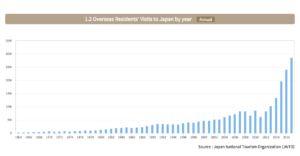
(Number of Inbound tourists by year)
(Inbound tourists by country in 2017)
That said, Hida-Takayama (飛騨高山)has become one of major tourist destinations among the foreign tourists
but it is not that popular destination for average Japanese.
I have recently read an interesting article about Israeli tourists in Hida-Takayama and would like to share the Takayama city’s
strategy how they become one of the most popular tourist places among foreigners especially Jews.
According to Takayama city statistics, the number of Israeli visitors has increased from mere 2,833 in 2013 to over 10,000 mark for the first time in 2016. The number has more than triple.
Total number of Israeli visitors to Japan during 2016 was about 30,000 so one-third of them visited Takayama.
In 2017, the total number of Israeli guests to Japan increased to 32,000 from previous year (up 7%)
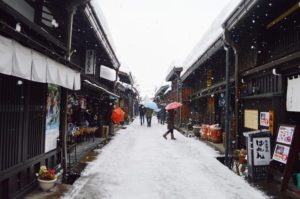
(Chic Hida-Takayama old town village with historical kominka)
Background
What is Takayama city and where is it ?
Statistics
Gifu prefecture
Gifu Prefecture (岐阜県 Gifu-ken) is a prefecture in the Chūbu region of central Japan.
Its capital is the city of Gifu.Located in the center of Japan, it has long played an important part as the crossroads of Japan, connecting the east to the west through such routes as the Nakasendō.
Population : 2,000,000 (18th among 47 prefectures/metropolitan)
Takayama-city
Takayama-city is located in northern Gifu Prefecture, in the heart of the Japan Alps. Mount Hotakadake is the highest point in the city at 3,190 metres (10,470 ft). The city has the largest geographic area of any municipality in Japan.
As of 1 December 2017, the city had an estimated population of only 89,278 in 35,464 households.,
The city is popularly known as Hida-Takayama (飛騨高山) in reference to the old Hida Province to differentiate it from other places named Takayama. The name ‘Takayama’ means ‘tall mountain’.
Shirakawa-gō (白川郷), formally Shirakawa-mura (白川村), is a historic village in Gifu.
It is about 350 km from Tokyo and 170km from Nagoya.
This small and remote city with population of 90,000 has received lofty 461,000 foreign visitors in 2016 (up 27% from the previous year).
Now for the surprise, substantial 10,504 Israeli guests visited and stayed there (2% of total)
Israeli visitors’ share is overwhelmingly high at 2% in Takayama city considering its share of total is less than 1% (and its population mere 8.8 million)
Number of foreign visitors in Takayama city (overnight visitors) in 2016.
- Taiwan 89,111
- Hong Kong 58,070
- Thailand 35,208
- China 32,465
- Australia 23,144
- USA 21,642
- Spain 20,549
- Singapore 16,001
- Italy 13,079
- France 12,795
- Israel 10,504
It is amazing to note Taiwan tops the list and China comes only 4th as China is by far 1st in total visitors in Japan (about 24% share)
Old town village
There is a district in the city renowned for nationally recognized Important historical building preservation area.(old town village)
You can see many pretty kominka (古民家, traditional Japanese folk house) on the street.
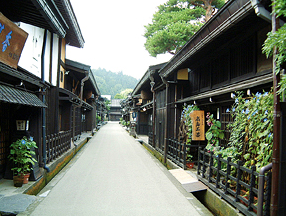
(Old town village in Takayama)
The town village still stands on the east side of the Miyagawa River flowing through Takayama, and in the middle of it is Sanmachi, where Edo period houses remain. The rich atmosphere of Takayama castle town still lingers, and you can see sake breweries and merchants’ houses with latticed bay windows standing in a row.
(Onsen in Okuhida)
“Okuhida-Onsengo Village,” an onsen hot spring resort, is located approximately one hour by car from Takayama City Center. “Okuhida-Onsengo” is the comprehensive name of five onsens: Hirayu, Fukuji, Shinhirayu, Tochio and Shinhotaka. The area is spread out across the foot of the Northern Alps. With abundant hot springs, the village has the largest number of open-air baths in Japan. Much of the most beautiful mountain scenery in Japan is nearby. Visitors can thoroughly enjoy relaxing in the baths surrounded by majestic nature.
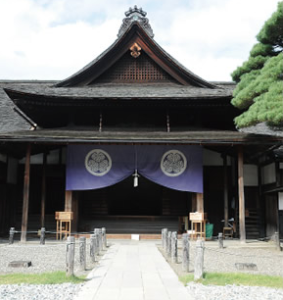
(Elegant local governor’s office)
This was a local governor’s office during the Edo period. There once were more than 60 similar buildings in Japan, however Takayama Jinya is the only one left today. It was in official use from 1692 to 1969.
Nature
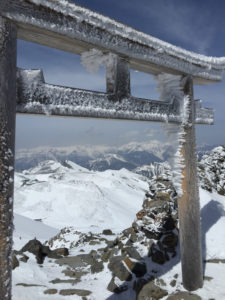
(Superb view at Mt. Norikura)
Mt. Norikura is located on the south end of Japan’s Northern Alps (Hida Mountain Range) and at the border of Takayama City, Gifu Prefecture and Matsumoto City, Nagano Prefecture. Mt. Norikura has magnificent mountain scenery with 23 peaks-the main peak Kengamine is3,026 meters above sea level-7 crater lakes and 8 plains. From Mt. Norikura, visitors can see Mt. Yari and the Hotaka Mountains above the clouds. At Norikura Skyline at 2,702 meters above sea level, there is a 4 hectare “tatami-daira” plateau with flowers. Visitors will enjoy viewing the beautiful alpine flowers in the summer. Mt. Norikura is designated as a specially preserved national park area. The mountain is a rich repository of natural resources such as the natural monument “raicho” (thunder bird) and other rare animals and plants.
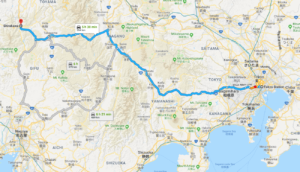
(Map: Tokyo-Shirakawa-go)
(Map: Nagoya-Shirakawa-go)
Together with neighboring Gokayama (五箇山)in Toyama, it was registered as a UNESCO World Heritage Site in 1995.
It is in the remote mountains that span from Gifu to Toyama Prefectures.
The area is often referred as ‘Hida-Takayama Chiho’ (Hida-Takayama area).
They are famous for their traditional gassho-zukuri (合掌作り)farmhouses (kominka style farmnhouse, 合掌作り), some of which are more than 250 years old built in a unique architectural style.
The name ‘gassho means’ means “hands together” as in prayer, referring to the steep roofs that keep the snow off in the winter.
Underneath the roofs, the large attic area was used to house silkworms.
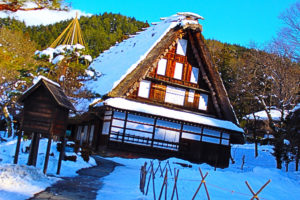
(Iconic gassho-zukuri kominka house)
Another feature which has brought fame to the village is the recent Japanese game series ‘Higurashi no Naku Koro Ni’ (2002) and the anime series that followed.
Higurashi: When They Cry (ひぐらしのなく頃に Higurashi no Naku Koro ni, lit. When the Evening Cicadas Cry), known simply as When They Cry for the North American release of the anime adaptation, is a Japanese murder mystery dōjin soft sound novel series produced by 07th Expansion.
Although the village residents are not too thrilled that an anime series depicting large levels of violence has based itself on their village, it has brought the tourists none-the-less.
A number of locations from the anime series can be visited in Shirakawa; the most prevalent site being the Hachiman Shrine, the site where the shrine maiden Rika Furude met an unfortunate end and also the major shrine of the village.
Hida-Takayama where the old town scape from the Edo period remains.
Today Israeli people visiting Hida-Takayama in Takayama City, Gifu Prefecture, which is well-knowns for the four major morning markets in Japan, are rapidly increasing.
“Shalom” is often heard in the famous morning market of Hida Takayama. It means “Hi” in the Hebrew.
There also have been many foreign tourists visiting Hida-Takayama from that kind of streetscape, we hear not only English and Chinese but also other languages such
as Thai, Korean, German, French, Spanish. Walking maps are full of these languages, which is not really common even in Tokyo.
In this city where you can say “foreign friendly”, so to speak, the officials from local governments particularly have been focusing on Israeli tourists.
When you actually walk in the city of Hida-Takayama, you often see Israeli tourists.
But why are so many Israeli people visiting Hida-Takayama ?
Chiune Sugihara
(see the link below)
The reason goes back to the date of the Nazi era.
During the Second World War, Jewish refugees who have escaped seeking a place of security from Poland and other parts of Europe
due to the persecution of Nazi Germany.
In that era, Mr. Chiune Sugihara who served as a consular in Lithuania,
has issued so-called a “Visa of Life” to them for helping them escape, and it is said he eventually saved about 6000 Jewish lives.
This humanitarian achievement also known as “Schindler of Japan” is widely known among Jews, and we see the number of Israeli visitors to the “Sugihara Chiune Memorial Museum”
in Yaotsu-cho, Gifu Prefecture.
Local Initiatives
And local officials have realized the fact that when Israeli tourists visit the Sugihara Chiune Memorial Museum, Israeli tourists frequently go around Takayama-shi and Shirakawa villages
in the vicinity.
A wide area tourist routes are then called as “Sugihara Chiune route”.
The officials cooperate with neighboring municipalities along the route and developed the promotion to the world.
They have not just targeted just tourists from Israel but Gifu Prefecture, in collaboration with Chubu JTB(travel agent), also opened a “Visa for Life” “Sugihara Chiune Travel Information Center”
in New York and Los Angeles where many Jews live, in order to make it widely available to the Jews.
In addition to providing information on facilities related to Sugihara Chiune and other tourists destinations nearby, they are happy to arrange for
transportation and accommodation.
The officials are working on all the means to inform the people in the source countries, such as organizing tours that guide the major media of the Jewish medias with visit to the Sugihara Chiune Memorial Museum and Shirakawa-go.In addition, at the International Tourism Exhibition held in Tel Aviv, a booth to promote the charm of “Sugihara Chiune Route” was set up, and it was particularly popular among exhibitions around the world.
There were participants who watched in tears the video showing the Tsuruga port(敦賀港), the only port in Japan, where Jewish refugees with “Visa of Life” landed.
People in the industry have faced some challenges such as dietary requirement for the religious people.
For many temporal Jews mainly in Tel Aviv, there are some sects whose religion has limited influence on lifestyle who are enjoying ramen using pork (which is usually forbidden). On the other hand, in the case of the devout Jews who strictly emphasize the commandments, all labor is prohibited from Friday sunset to Saturday as Jewish Sabbath. Average Japanese could get confused about such religious rule if there is no education in Jewish Sabbath.
Here are the key strategies which local governments took to increase the foreign tourists over
20 years.
Key Strategies
Core concept : ”Offer the experience of Japanese ordinary event in daily life”
・Cooking class using usual Japanese ingredients
・Hiking and going by bicycle around rural rice field
・Dining at casual Chinese restaurant which ordinary Japanese people daily dine
(Key strategy of Takayama city)
Strategic promotion plan
・PR materials from the perspective of visitors (i.e. Chifune Sugihara hall)
・Collaboration between private sectors and public sectors
・Wide range of vicinity collaboration (not too focusing on own areas)
・Cross promotion with local cuisine (at source countries) and sight-seeing events
(Key strategy of Takayama city)
(Hida-Takayama in spring)
Tactical initiatives
・Wide range of free Wi-Fi supply
・Muslim friendly facilities
・Produce a number of specially trained guides in foreign language
・Multi-language paper materials and map (10 languages)
・Improve the convenience in the public transportation
・Produce the special package tours such as ‘visiting Michelin 3 stared destinations tour’
・One stop duty free arrangement facility
(senbei: Japanese cracker)
(Key strategy of Takayama city)
(Key strategy of Takayama city)
Final Thoughts
What do you think of the strategy ? Agree ? It is worthwhile to note they have been making effort for 20 years, a way before the
current inbound tourism booming has come around.
My takeaways
1.Build the big picture strategy first. Japanese organizations often tend to focus the detailed tactical initiatives before they
build the strategy.
2. Always focus on the perspective of the guests not Japanese.
Product-out approach often fails in the tourism industry, too.
3. Language matters
Foreigners will feel more comfortable and welcoming atmosphere when they see the signs in their own language.
There was a quote in the Japanese article about the words from Israeli man in their 60s
“I came with my wife this time, but I feel tears when I think of Mr. Sugihara’s achievements at the time. I would like you to know this valuable historical fact more widely around the world, first to my son who has never been to Japan. I also want my son to visit and feel the bond between Japan and Israel, so knowing the warmth of one man remains much more deeply than reading history books. “
I do think Japan is underlining the untapped potential places for foreign tourists and there are so many
destinations wrapped in obscurity all over Japan. Japan still has a lot to offer for foreign tourists.
As for the real estate equation, considering the situation where Airbnb recently stopped displaying listings from hosts in Japan
that had not obtained permission to operate, as a law in the country for private home-sharing, known as minpaku, is slated to take effect from June 15, 2018, it is a good opportunity to make investment in places like Hida-Takayama where a lot of foreign visitors are coming.
(and avoiding the competition like Tokyo or Kyoto).
Foreign tourists love the quest of both old and new Japan and traditional Japanese folk houses(kominka) certainly shall maximize the authenticity of old Japan experience. If you can find a sexy kominka property in good condition hopefully with proper hotel license in Hida-Takayama area (or even other locations), your vacation rental property would pay a big dividends.
Without a doubt, there’s never been a better time for making such investment. Intrigued ?
Enough from us, for more details, please don’t hesitate to contact us.
P.S.
Hida-Beef
For beef and sushi lovers, Hida-Takayama is notable for the beautiful Japanese wagyu beef.
Hida-gyu, known as one of the finest quality varieties of beef, meets every standard, and is of the highest quality in marbling, luster, color, texture and smell.
The amount of marbling, the determining factor in the quality of the meat, depends on genetic factors and farming techniques.
The origin of today’s Hida-gyu brand was a farmer’s encounter with a single bull named ‘Yasufuku’ in 1981. Yasufuku is said to have had the ideal genetic makeup to produce calves with high quality meat, and that he produced 39,000 offspring in his lifetime.
Supported by superior biotechnology research and the passion of the farmers, we produce high quality, safe Hida-gyu for our customers.
You can’t miss relishing the local culinary delight, ‘hida-gyu beef sushi’ there .
(Five-star quality Hida beef sushi)
Takayama Ramen
(Takayama ramen: Takayama is notable for its local ramen)
A bowl of thin curly noodles and soy-based broth. Ramen broth is typically made by placing the base (kaeshi) in a bowl and dissolving it with the hot broth; but for Takayama Ramen, the broth and the base are boiled together. The taste and ingredients vary depending on the shop, so you should try different ones and compare them.
(Vintage gassho-zukuri kominka in Hida-Takayama : 合掌作り古民家)
Other Helpful Articles About Kominka and minpaku law
Are you interested in buying kominka (traditional Japanese folk house, 古民家)in Japan ?: Tips for buying and renovating kominka
Our Consultation Service
Spot consultation is available for those who are interested in buying an old Japanese property.
Spot consultation fee starts from 50,000 yen per two hours (plus tax). Consultation over Internet telephone is possible for those who are distant from Tokyo.
If you are seriously interested in buying akiya, please contact us. Consultation fee starts from 50,000 yen per two hours (plus tax). We provide the following consulting service for akiya investment as well.
1) Akiya search service
100,000 yen (plus tax) per project. We will look for an appropriate akiya for you.
It requires time consuming process.
Finding a good akiya is not as easy as you might think.
If you buy a wrong property in a wrong location, your investment could be a disaster.
We will not search akiya for free.
If you are seriously interested in buying a Japanese old house, please contact us.
Relevant articles
The Chiune Sugihara Memorial Hall(In English)
Takayama city tourism paper statistics (in Japanese)
Takayama city tourism strategy (in Japanese)
Takayama city tourist information (in English)
Report by Nikkei : Airbnb to remove 80% listing (in English)
Toshihiko Yamamoto
Real estate investing consultant and author.
Founder of Yamamoto Property Advisory in Tokyo.
International property Investment consultant and licensed
real estate broker (Japan).
He serves the foreign companies and individuals to buy and sell
the real estates in Japan as well as own homes.
He holds a Bachelor’s degree in Economics from
Osaka Prefecture University in Japan
and an MBA from Bond University in Australia
Toshihiko’s book, “The Savvy Foreign Investor’s Guide to Japanese Properties: How to Expertly Buy, Manage and Sell Real Estate in Japan”is now out on Amazon, iBooks (iTunes, Apple) and Google Play.
About the book
Amazon.com Link

